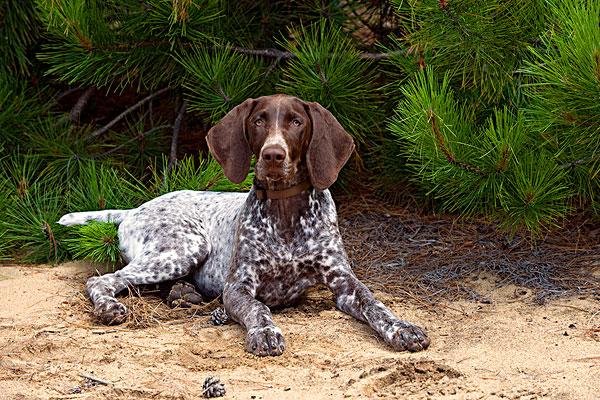Canis lupus familiaris
IUCN
LCBasic Information
Scientific classification
- name:Canis lupus familiaris
- Scientific Name:German Shorthaired Pointer,Deutsch Kurzhaar
- Outline:Carnivora
- Family:Canidae
Vital signs
- length:53-63cm
- Weight:20-32kg
- lifetime:12-15 year
Feature
Smart, alert, agile, and easy to tame, it can capture any prey and give instructions. If it cooperates with other hunting dogs to hunt, it can play a huge role in bushes, mountaintops, and cliffs.
Distribution and Habitat
It originated in what is now Germany in the 19th century.
Appearance
The head is well-defined, neither too light nor too heavy, and in proportion to the body. The eyes are of medium size, full of intelligence and expression, very cheerful, but also radiating vitality, neither protruding nor sunken. The shape of the eyes is almond-shaped, not round. The ears are wide and set fairly high, lying flat, never hanging on the head. The skull is moderately broad, slightly arched on the sides, and slightly rounded on the top. The foreface rises gradually from the nose to the forehead. This rise is more obvious and prominent in males than in females. The jaws are strong and very muscular. In the rising line towards the forehead. The neck is long enough to enable the jaw to reach out and pick up prey, sloping down to form a beautiful curve. The nape of the neck is well-muscled, gradually thickening towards the shoulders, and the skin is close and close. The chest gives the impression of depth rather than width; the chest is in correct proportion to the rest of the
Details
The German Shorthaired Pointer originated in the 18th century. Speaking of the origin of the German Shorthaired Pointer, it is mainly based on the Spanish Pointer, and then it was mated with the Italian and British Pointers to produce a new Pointer bloodline, namely the German Shorthaired Pointer. It was recognized by the American Kennel Club in 1930. The dog can hunt quail, grouse, partridge, woodcock, duck, hare, raccoon, kangaroo, etc. It is also often used to track and catch deer.

The German Wirehaired Pointer has a noble appearance and a strong body. It is divided into four types according to different activity characteristics: German Wirehaired Pointer, Curly-haired Pointer, Spiny-haired Pointer, and Griffon. Most of the early Wirehaired Pointers represent a collection of Griffons, Spiny-haired Pointers, Curly-haired Pointers, and German Wirehaired Pointers. The Curly-haired Pointer is a cross between a Poodle and an English Pointer, while the Griffon and the Spiny Dog are crosses between a Pointer, a Foxhound, a Curly-haired Pointer, and a Polish Water Dog.
The German Wirehaired Pointer is unique in that its hair is straight and coarse, and feels rough, and some people call it "wire-like". The hair is versatile, with a thick undercoat in winter to resist the cold, and a thin undercoat in summer to dissipate heat. In addition, it has a certain waterproof effect, and can basically adapt to any environment. The color of the German Wirehaired Pointer's hair is liver-colored and white. The head is usually liver-colored, sometimes with white streaks, and the ears are liver-colored.
The German Shorthaired Pointer is an all-purpose hound, a multi-purpose gun dog that can perform a variety of difficult tasks in water and on land. In judging the German Shorthaired Pointer at the show, consideration must be given to whether he reflects this basic character. The animal that appears to the observer is a noble, well-balanced, well-proportioned animal, whose overall structure indicates strength, endurance, agility, and a very intelligent appearance. It is neither too small nor too large. The impression given is of medium size, but very much like a strict hound, "short back, but with ample length when standing." Symmetry and field fitness are essential. Thus, a solid but lean dog is not to be penalized under field conditions; but in any case, excessive fatness or lack of muscle is to be penalized. A smooth, well-proportioned German Shorthaired Pointer is far more desirable than one with both outstanding merits and faults. The graceful outline, the well-defined head, the sloping shoulders, the deep chest, the powerful back, the strong limbs, the good bones, the ample muscle, the well-carried tail, and the neat coat indicate nobility and indicate the ancient traditions of the breed. The tradition is more clearly shown in the smooth, harmonious and alert movements, and also without any unnecessary movements. In the early days, he was an excellent working dog, and now he is a very popular family companion dog. Whether as a working dog or as a family companion dog, the German Wirehaired Pointer will always bring positive energy to people.
Protect wild animals and eliminate game.
Maintaining ecological balance is everyone's responsibility!








